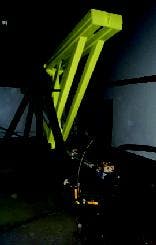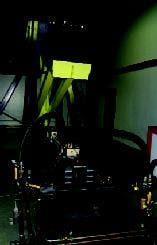Simulators have gone mainstream in the past decade. Go to your nearest zoo, county fair, amusement park, or even shopping mall, and you may encounter the newest generation of motion simulators. Flight simulators, too, have come a long way — these complex machines are a far cry from the simple electromechanical devices from the 1930s. Today's flight simulators often rely on super precision hydraulic servo actuators.
Using simulators, pilots can train for situations that they're unable to safely do in an actual aircraft. They may simulate loss of flight surfaces or complete power loss. But this begs the question — how do we know that the simulators themselves are working properly?
Servo Kinetics Inc., Ann Arbor, Mich, has developed a sophisticated testing process for simulator actuators. Called the Simulator Motion Actuator Certification Rig (SMACR), it is a dynamic test machine used for the certification of flight simulator servo hydraulic actuators. It is also the largest test rig of its type in the world, having a maximum slug weight capacity of 45,000 lb, and can test actuators with strokes to 80 in.
Refurbishing the actuators
The SMACR performs all necessary tests required to certify that the actuator's performance characteristics meet the original specifications, allowing it to be put back into service after refurbishment.
The refurbishment process itself is extensive, as virtually none of the internal parts of the actuator are reused — the only exception being the actuator rod, which is sent out for straightening, grinding, hard chroming, and finish grinding. This approach to actuator refurbishment eliminates the variance in testing results due to reinstalling used or reconditioned internal parts in one actuator, as opposed to all new internal parts in another actuator.
This becomes critical when refurbishing six actuators that all came off the same motion base and will be installed back on that same motion base — variances in actuator performance can cause severe problems. If problems occur, the simulator may not be certified to its previous level by the FAA.
Other areas of concern when refurbishing a simulator motion base are the upper and lower mounts that the servo actuators are connected to — mounts should be requalified as to the condition of the bearings, axle shafts, and clevis pins. Excessive free movement or binding will migrate into the servo actuator, causing unacceptable friction and even unintended movements.
Each refurbished actuator is put through numerous tests, including: c compression c tension c upper and lower cushions c turn-around friction, and c phase lag test.
Servo Kinetics recently completed a two and a half year project on the refurbishment of 59 servo actuators for the U.S. Air Force that are used on the C-130, flight training simulators. In 2003, they refurbished the Shuttle Flight Simulator for United Space Alliance/NASA Houston. They also have a long standing contract with CAE Inc., Montreal, the largest manufacturer of flight simulators for commercial and military applications.
For more information, visit www.servokinetics.com.



